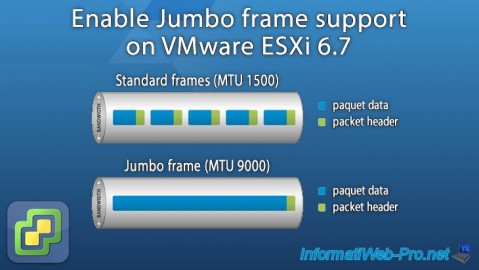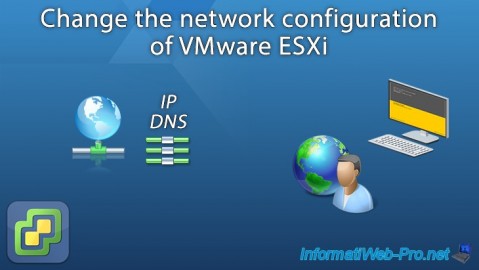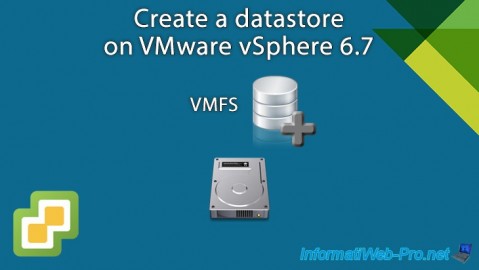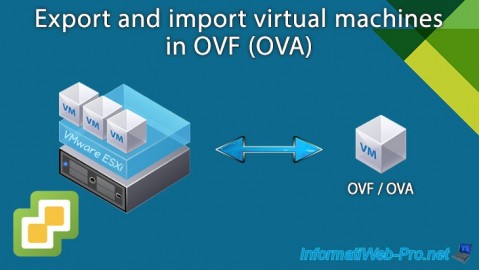Add a VMkernel interface (vmkX) on a VMware ESXi 6.7 hypervisor on VMware vSphere 6.7
- VMware
- VMware vCenter Server (VCSA), VMware vSphere
- 21 August 2024 at 07:57 UTC
-

- 2/2
3. Network configuration on the 2nd VMware ESXi hypervisor
On your 2nd hypervisor, create the exact same networking (except the IP address for your VMkernel adapter will be slightly different).
To do this, select your 2nd hypervisor and go to "Configure -> Networking -> Virtual switches" and click on: Add Networking.

In the "[VMware ESXi host name] - Add Networking" wizard that appears, select "VMkernel Network Adapter".

Select "New standard switch".

Add at least one physical adapter to it so that the host can communicate over the physical network.

Configure exactly the same as for the 1st VMware ESXi host for the port properties.

For IPv4 settings, select "Use static IPv4 settings" again and use a different IP address from the 1st host that is on the same network.
In our case, this 2nd VMware ESXi host will use the IP address "10.10.0.12" for vMotion traffic.
Note: as a reminder, our 1st VMware ESXi host uses the IP address "10.10.0.11" for vMotion traffic.

A summary of the network configuration to be created appears.
Click Finish.

Your virtual switch and its dependencies were created on your 2nd VMware ESXi host.

4. Test network connectivity between 2 VMkernel adapters
To test network connectivity between 2 VMkernel adapters, you will need to connect to your VMware ESXi host from the command line (via SSH).
To do this, select your 1st host and go to "Configure -> System -> Services".
In the list of services that appears, start the "SSH" service.

Note that on VMware vSphere Client, enabling the SSH service will automatically display a warning "SSH for the host has been enabled".
Hence the appearance of a small yellow triangle on the icon of your VMware ESXi host.
If you would like this warning to no longer appear, click the "Supress Warning" link to the right of this warning.

In the "Supress shell access warnings" window that appears, answer "Yes" to the question to suppress the enabled local and remote shell access warnings.

The warning has disappeared and the "SSH" service remains enabled.

Connect via SSH to your first VMware ESXi host using PuTTT (for example).

To test network connectivity using a VMkernel adapter and a specific TCP/IP stack, use the "vmkping" command as below.
- -S vmotion: allows you to indicate to the "vmkping" command that the network test must go through the "vMotion" TCP/IP stack.
Otherwise, the "vmkping" command will use the TCP/IP stack by default. - -I vmk1: indicates that the network test should be performed using the VMkernel adapter "vmk1".
That is, the VMkernel adapter you just created for vMotion traffic. - 10.10.0.12: the IP address set on the new VMkernel adapter on the remote VMware ESXi host.
Bash
vmkping -S vmotion -I vmk1 10.10.0.12
If the network test passes, you will get this:
Plain Text
PING 10.10.0.12 (10.10.0.12): 56 data bytes 64 bytes from 10.10.0.12: icmp_seq=0 ttl=64 time=0.835 ms 64 bytes from 10.10.0.12: icmp_seq=1 ttl=64 time=0.558 ms 64 bytes from 10.10.0.12: icmp_seq=2 ttl=64 time=0.901 ms --- 10.10.0.12 ping statistics --- 3 packets transmitted, 3 packets received, 0% packet loss round-trip min/avg/max = 0.558/0.765/0.901 ms
To learn more about network testing via a VMkernel adapter and a specific TCP/IP stack, refer to our previous tutorial: VMware ESXi 6.7 - Add a VMkernel interface.
Share this tutorial
To see also
-

VMware 3/24/2023
VMware ESXi 6.7 - Enable Jumbo frame support
-

VMware 7/15/2022
VMware ESXi 7.0 / 6.7 - Change the network configuration (IP and DNS)
-

VMware 4/17/2024
VMware vSphere 6.7 - Create a datastore
-

VMware 5/29/2024
VMware vSphere 6.7 - Export and import VMs

No comment